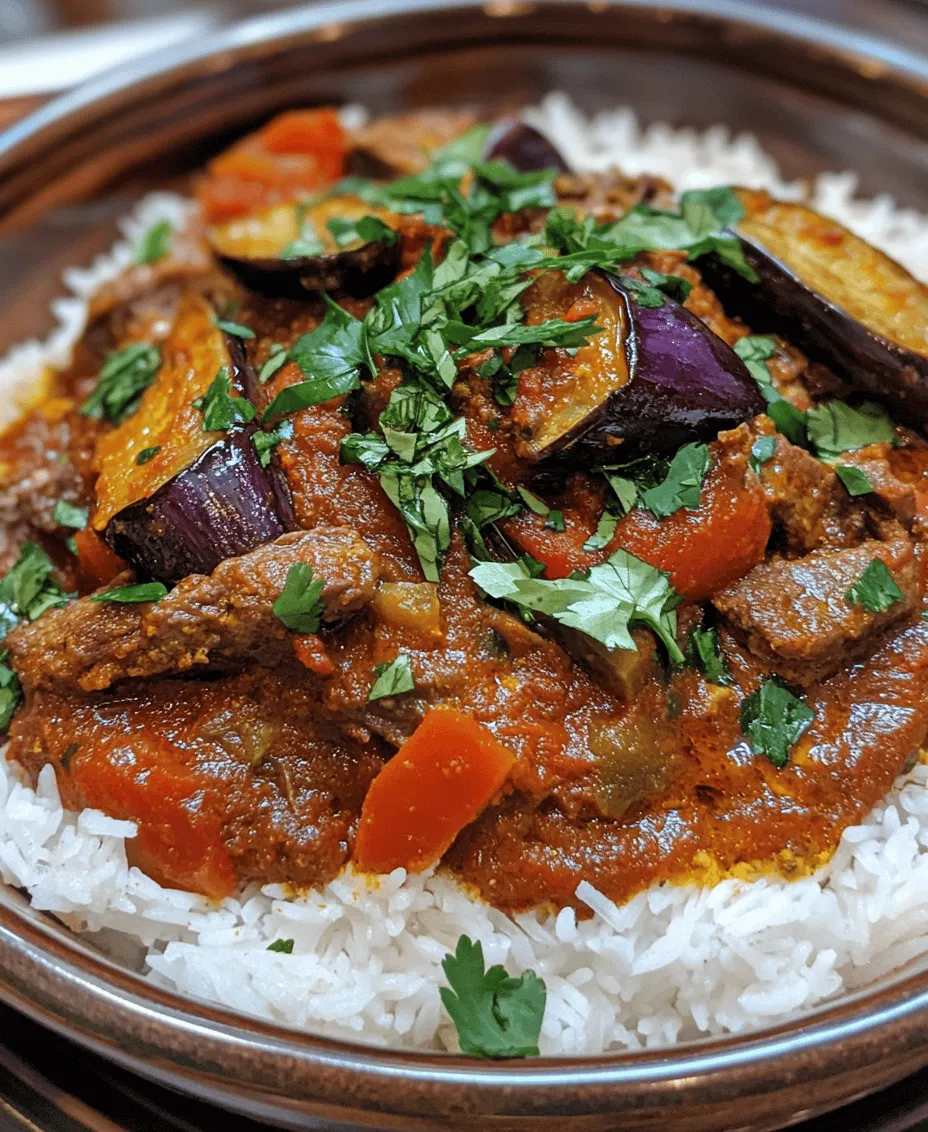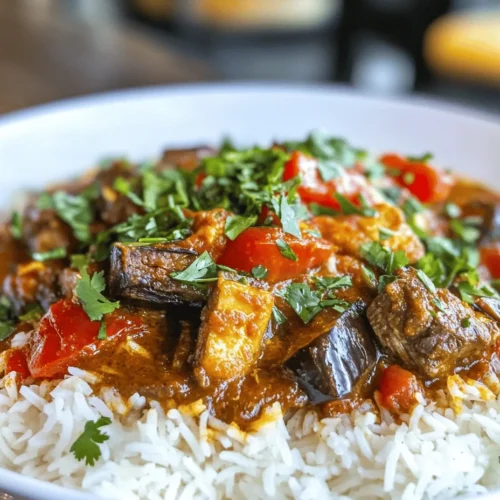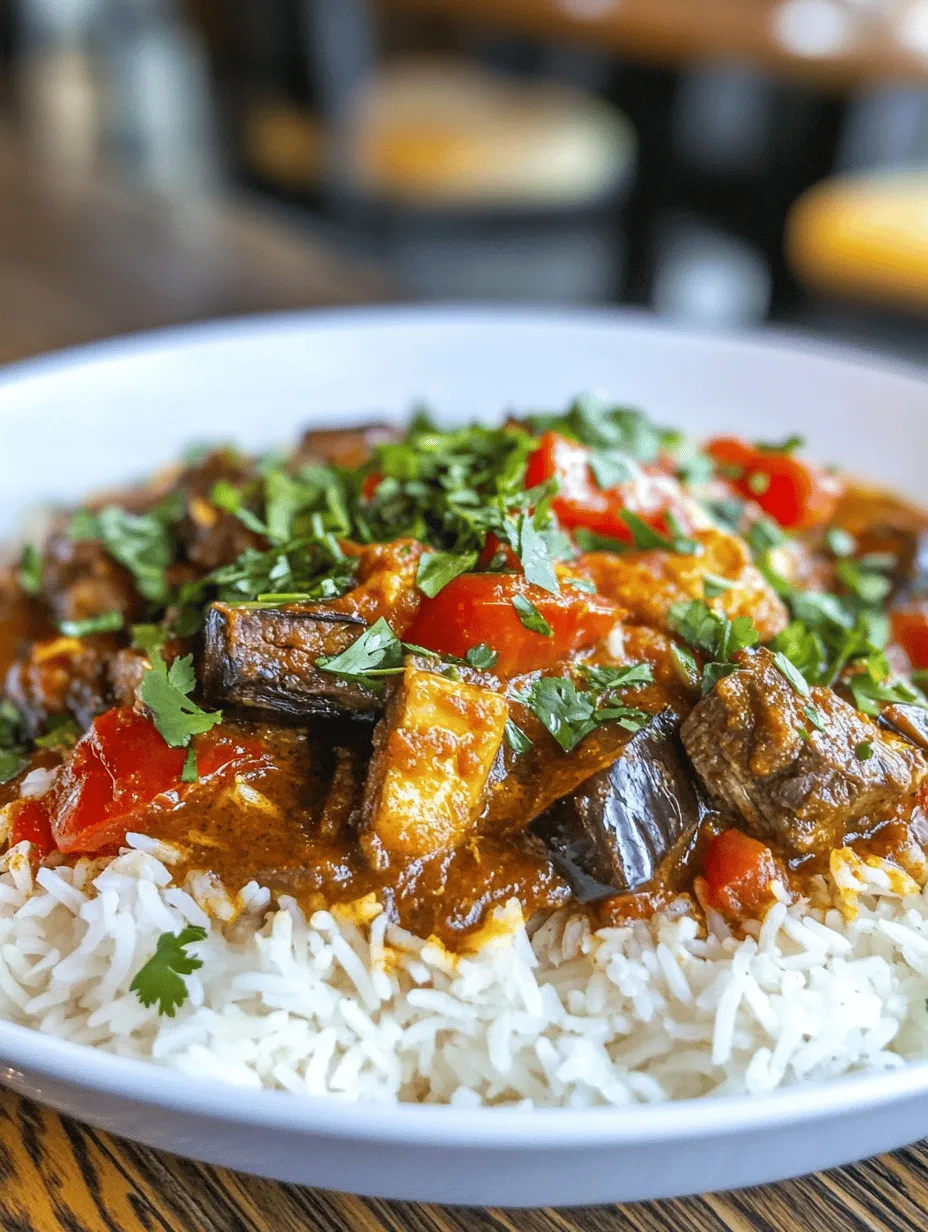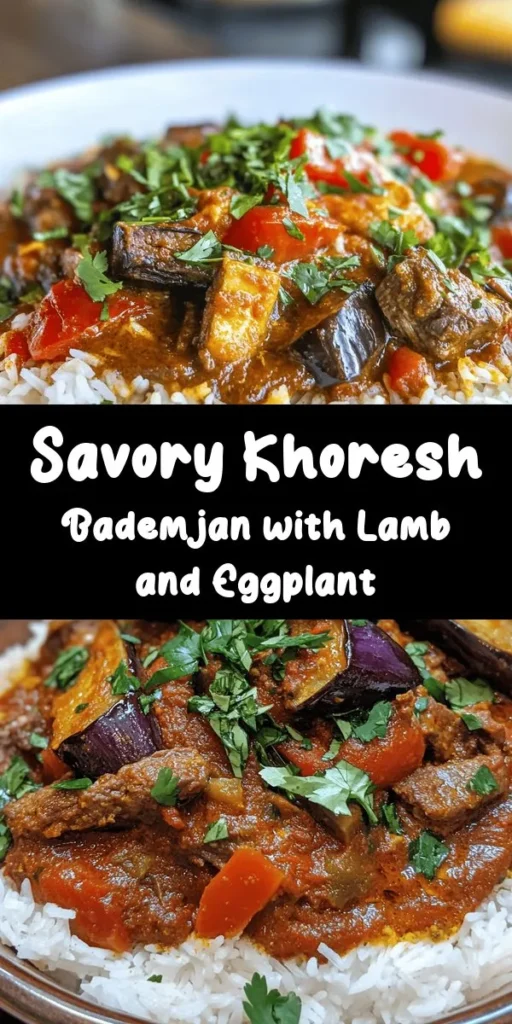Introduction
Khoresh Bademjan, a cherished dish from the heart of Persian cuisine, is more than just a meal; it’s an experience steeped in tradition and rich flavors. Translated as “eggplant stew,” Khoresh Bademjan is a staple in many Iranian households, often gracing the table during family gatherings, celebrations, and everyday dinners alike. This delightful dish showcases the culinary artistry of Iran, blending tender meats, vibrant spices, and the star ingredient—eggplant—into a harmonious stew that is both comforting and indulgent.
The popularity of Khoresh Bademjan lies not only in its incredible taste but also in its versatility. This dish can be tailored to suit various palates, making it a beloved choice among both vegetarians and meat lovers. The key components of Khoresh Bademjan include succulent pieces of lamb or beef, tender eggplants, and a medley of aromatic spices, all simmered together to create a rich and flavorful sauce. What truly sets this dish apart is the careful layering of flavors and the slow-cooking process, allowing each ingredient to contribute to a symphony of taste that is truly unforgettable.
In this article, we’ll delve deeper into the world of Khoresh Bademjan, exploring its significance and history in Persian culture, the essential ingredients that make this dish shine, and a step-by-step guide to preparing it at home. Whether you are a seasoned chef or a culinary novice, you’ll find that making Khoresh Bademjan is a rewarding endeavor that will bring the essence of Persian cuisine right to your kitchen.
Understanding Khoresh Bademjan
Khoresh Bademjan is a quintessential Persian stew characterized by its deep flavors and the prominent use of eggplants. Traditionally, the dish is made by slow-cooking meat—commonly lamb or beef—with spices, tomatoes, and eggplant until everything is tender and infused with flavor. The dish is typically served with steamed basmati rice, allowing the rich sauce to soak into the grains and enhance every bite.
The cultural significance of Khoresh Bademjan runs deep in Iranian society. It is often associated with home-cooked meals and the warmth of family gatherings. In Persian culture, food is a means of connection and expression, and Khoresh Bademjan embodies this philosophy. The dish is frequently prepared for special occasions, festivals, and gatherings, symbolizing hospitality and generosity.
Historically, Khoresh Bademjan has evolved through various regions of Iran, leading to several regional variations. For instance, in some parts of Iran, the stew may incorporate additional vegetables or vary in spice levels, while others may focus on specific cooking techniques that enhance the dish’s flavor profile. Despite these variations, the essence of Khoresh Bademjan remains consistent: a delicious, hearty stew that tells the story of Persian culinary tradition.
Ingredients Breakdown
To create an authentic Khoresh Bademjan, a careful selection of ingredients is crucial. Each component contributes to the overall flavor and texture of the dish, resulting in a balanced and satisfying meal.
1. Eggplants
Eggplants are the star of Khoresh Bademjan. Their creamy texture and ability to absorb flavors make them an ideal addition to the stew. When preparing eggplants, it’s essential to salt them before cooking to draw out excess moisture and bitterness. This process, known as “sweating,” enhances the flavor and ensures the eggplants achieve a tender, melt-in-your-mouth consistency during cooking.
2. Meat Choices
The choice of meat in Khoresh Bademjan significantly impacts the dish’s flavor. Lamb is the traditional choice, known for its rich flavor and tenderness. However, beef is also commonly used and can provide a heartier texture. Both options work well in the stew, but the cooking times may vary slightly based on the cut chosen. Slow-cooking the meat allows it to become tender and absorb the aromatic spices, resulting in a delicious sauce.
3. Aromatics
Onions and garlic form the aromatic base of Khoresh Bademjan. Onions are typically sautéed until golden brown, releasing their natural sweetness and adding depth to the dish. Garlic is often minced and added to the onions, infusing the stew with its distinctive flavor. Together, these ingredients create a flavorful foundation that enhances the overall profile of the dish.
4. Spices
The magic of Khoresh Bademjan lies in its spices. Common spices used in this dish include turmeric, cumin, and cinnamon. Turmeric not only adds a warm color but also contributes a subtle earthiness. Cumin offers a nutty flavor that complements the meat and eggplant, while cinnamon adds a hint of sweetness that balances the savory elements. These spices not only enhance the flavor but also offer various health benefits, including anti-inflammatory properties and digestive support.
5. Tomatoes
Tomatoes are another essential ingredient in Khoresh Bademjan. They provide acidity and sweetness, brightening the overall flavor of the stew. While fresh tomatoes can be used, canned tomatoes are often preferred for their convenience and consistent flavor. The choice between fresh and canned tomatoes may depend on the season and personal preference, but both options can yield a delicious result.
6. Optional Ingredients
For those looking to elevate their Khoresh Bademjan, saffron and fresh herbs can be wonderful additions. A pinch of saffron can add a luxurious aroma and vibrant color to the dish, while fresh herbs like parsley or cilantro can be used for garnishing, providing a refreshing contrast to the rich stew.
Preparation Steps
Now that we’ve explored the ingredients that make Khoresh Bademjan a delightful dish, let’s dive into the preparation steps. The process may seem intricate, but with a few key techniques, you’ll be well on your way to creating a delicious stew that showcases the flavors of Persian cuisine.
1. Prepare the Eggplants
Start by washing the eggplants and slicing them into thick rounds or half-moons. Place the sliced eggplants in a colander, sprinkle them generously with salt, and let them sit for about 30 minutes. This will help draw out any bitterness and excess moisture. After 30 minutes, rinse the eggplants under cold water and gently pat them dry with a clean kitchen towel.
2. Brown the Meat
In a large pot or Dutch oven, heat a few tablespoons of oil over medium heat. Add the cubed meat (lamb or beef) and season with salt and pepper. Sear the meat until it is browned on all sides, which should take about 5-7 minutes. This step is crucial as it helps lock in the juices and adds depth of flavor to the stew.
3. Sauté the Aromatics
Once the meat is browned, remove it from the pot and set it aside. In the same pot, add diced onions and sauté them until they become translucent and slightly caramelized, about 10 minutes. Next, add minced garlic and sauté for an additional minute until fragrant.
4. Combine Ingredients
Return the browned meat to the pot with the sautéed onions and garlic. Sprinkle in the turmeric, cumin, and cinnamon, stirring to coat the meat evenly with the spices. Cook for a couple of minutes to allow the spices to toast and release their flavors.
5. Add Tomatoes and Water
Incorporate the chopped tomatoes (fresh or canned) into the pot, stirring to combine. Pour in enough water or broth to cover the meat and tomatoes. Bring the mixture to a gentle boil, then reduce the heat to low, cover the pot, and let it simmer for about 1.5 to 2 hours. The slow cooking process will result in tender meat and rich flavors.
6. Fry the Eggplants
While the meat is simmering, heat some oil in a separate pan over medium heat. Add the prepared eggplant slices in batches, frying them until they are golden brown and softened. This step enhances the eggplant’s flavor and texture, making them a perfect addition to the stew.
7. Combine Everything
Once the meat is tender, gently fold in the fried eggplants into the stew. Allow the Khoresh Bademjan to simmer for an additional 30 minutes, uncovered, to meld the flavors together. This final step ensures that the eggplants absorb the delicious sauce while maintaining their integrity.
By following these preparation steps, you will create a Khoresh Bademjan that captures the essence of Persian cuisine and delights the palate. The combination of savory meat, creamy eggplant, and aromatic spices results in a dish that is not only delicious but also rich in cultural heritage.
In the next part of this article, we will explore additional tips for achieving the best results, common questions about Khoresh Bademjan, and how to serve this delightful dish to truly impress your family and friends. Stay tuned as we continue this culinary journey into the heart of Persian cooking!

Frying Techniques: Achieving the Perfect Golden-Brown Color
To create a delicious Khoresh Bademjan, the frying technique used for the eggplants and onions is crucial. Begin by slicing your eggplants into thick rounds, about 1-inch thick. Sprinkle them lightly with salt and allow them to sit for 20-30 minutes. This process, known as sweating, draws out excess moisture and bitterness from the eggplants, ensuring they fry beautifully and absorb less oil.
Once your eggplants are ready, heat a generous amount of vegetable oil in a large frying pan over medium-high heat. When the oil is hot (you can test this by dropping a small piece of eggplant into the oil; it should sizzle immediately), carefully add the eggplant slices in batches, ensuring not to crowd the pan. Fry each side until they achieve a rich golden-brown color, about 3-4 minutes per side. Once done, place the fried eggplants on a paper towel-lined plate to absorb excess oil. This step not only enhances the flavor of the dish but also adds a delightful texture.
Cooking the Meat: Tips for Ensuring Tenderness and Flavor
For the meat component in your Khoresh Bademjan, whether using lamb, beef, or chicken, achieving tenderness is key. Start by cutting your meat into bite-sized pieces, ensuring they are uniform in size for even cooking. Before adding the meat to your pot, sear it in a hot pan with a bit of oil to lock in the juices. This initial browning process enhances the flavor profile and creates a rich base for your stew.
After the meat is seared, transfer it to your pot and add finely chopped onions. Sauté the onions until they are translucent and fragrant, about 5-7 minutes. This step builds a flavorful foundation for the stew. Next, add garlic, sautéing briefly before incorporating tomatoes and your chosen spices. Using a combination of turmeric, cumin, and a hint of cinnamon will deepen the flavors of the stew.
Incorporating Spices: How to Layer Flavors Effectively
The key to a delicious Khoresh Bademjan lies in the careful layering of spices. Once you have sautéed your onions and garlic, it’s important to add your spices at this stage to allow their flavors to bloom. Sprinkle in turmeric, which adds a warm color and earthy flavor, along with cumin for a slightly nutty undertone. A dash of ground cinnamon can provide a surprising depth that beautifully complements the dish.
Stir the spices into the meat and onion mixture for a couple of minutes, allowing them to toast slightly before adding diced tomatoes and water. This technique helps release the essential oils in the spices and enhances their flavors, resulting in a more aromatic stew.
Simmering Process: Importance of Patience in Cooking Stews
Once all the ingredients are combined, it’s time to simmer the Khoresh Bademjan. Bring the mixture to a boil, then reduce the heat to low, allowing the stew to simmer gently. This slow cooking process is essential for melding the flavors together and ensuring that the meat becomes tender. Cover the pot with a lid, leaving a slight gap to allow steam to escape. Depending on the type of meat used, this simmering could take anywhere from 1.5 to 2 hours.
For best results, check the stew periodically, stirring gently to prevent sticking, and add water as necessary to maintain a saucy consistency. Patience is key; the longer you allow the stew to cook, the more flavorful and tender the meat will become.
Cooking Tips for Perfect Khoresh Bademjan
Adjusting Cooking Time Based on Meat Type and Cut: Different cuts of meat require varying cooking times. For example, tougher cuts like lamb shank may need a longer simmering period (around 2-3 hours) compared to chicken, which may be tender in just 30-45 minutes. Always check the meat for tenderness before serving.
Enhancing Flavors Through Seasoning Adjustments: Don’t hesitate to adjust seasonings to elevate the flavor. If you prefer a spicier profile, add a pinch of cayenne or chili powder. Conversely, for a milder taste, stick with the base spices. Tasting throughout the cooking process will help you achieve the perfect balance.
Making the Dish Vegetarian or Vegan-Friendly: To create a vegetarian or vegan version of Khoresh Bademjan, substitute the meat with hearty vegetables like mushrooms or chickpeas. You can also use vegetable broth instead of meat broth for added flavor. The eggplants and spices will still provide a rich and satisfying dish.
Serving Suggestions
Khoresh Bademjan is traditionally served with fragrant basmati rice, which beautifully complements the rich flavors of the stew. To prepare the rice, rinse it under cold water until the water runs clear, then soak it for about 30 minutes before cooking. This process removes excess starch and results in fluffy grains.
Complementary Side Dishes: Consider serving Khoresh Bademjan with a side of fresh herbs, such as Persian sabzi (a mix of fresh herbs) or a simple cucumber and tomato salad, known as Shirazi salad. These light and refreshing sides balance the richness of the stew and add a burst of color to your plate.
Presentation Tips: For an aesthetically pleasing presentation, serve the Khoresh Bademjan in a shallow bowl, garnished with fresh herbs and a sprinkle of pomegranate seeds. This not only enhances the visual appeal but also adds a sweet-tart contrast to the savory stew.
Nutritional Information
A typical serving of Khoresh Bademjan provides a well-rounded meal, rich in protein, healthy fats, and vitamins. Below is a breakdown of the nutritional values per serving:
– Calories: Approximately 350-450 calories (depending on meat choice)
– Protein: 30g (varies with meat type)
– Fat: 20g (mostly healthy fats from olive oil and eggplant)
– Carbohydrates: 25g
Health Benefits of Key Ingredients:
– Eggplants are high in fiber and low in calories, making them an excellent addition to a healthy diet. They are rich in antioxidants, which help protect the body from oxidative stress.
– Tomatoes provide vitamins C and K and are known for their heart-health benefits due to their lycopene content.
– Herbs and Spices not only enhance flavor but also offer various health benefits, including anti-inflammatory properties.
Portion Control and Dietary Considerations: When serving Khoresh Bademjan, consider portion sizes, especially if serving with rice. A standard serving of rice is about 1 cup, while a serving of the stew can be around 1 cup as well. This balance ensures a nutritious meal without excessive calories.
Conclusion
Khoresh Bademjan is more than just a dish; it is a celebration of Persian culture and culinary heritage. The combination of tender meat, flavorful eggplants, and aromatic spices make this stew a comforting staple in many Iranian households. By mastering the cooking techniques outlined in this guide, you can create a Khoresh Bademjan that not only delights your taste buds but also nourishes your soul.
I encourage you to try making this dish at home. The process of cooking Khoresh Bademjan can be a joyful experience, bringing family and friends together to share in the warmth of home-cooked food. As you explore Persian cuisine, remember that every meal shared is an opportunity to create lasting memories and enjoy the rich tapestry of flavors that this culture has to offer. Happy cooking!



